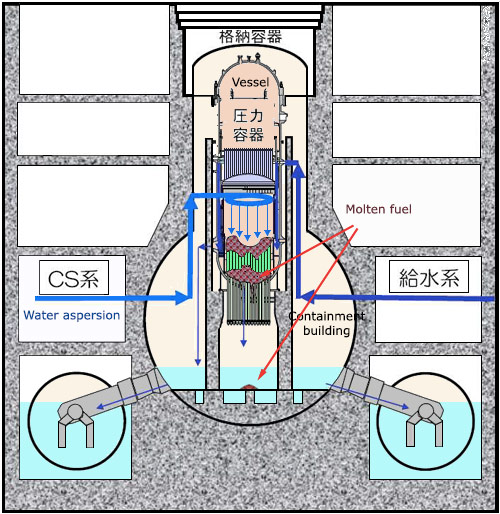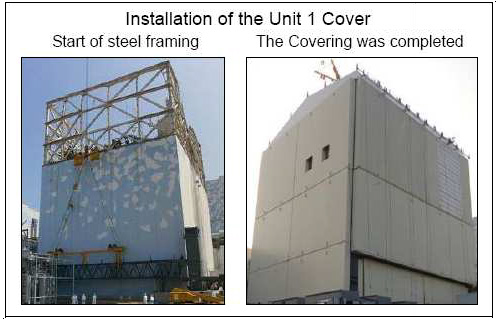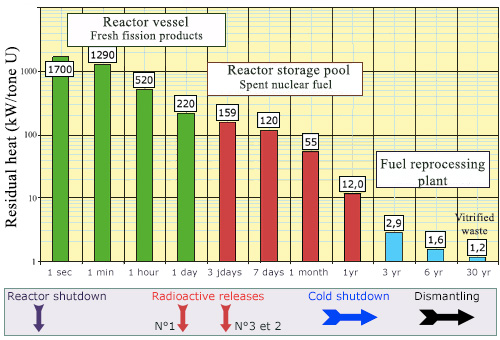A long way from reactors cold shutdown to their dismantling ..
Today, 8 years after the accident, the situation around the Fukushima reactors has much improved and can be considered stabilized, but the path that led to this stabilization proved to be long and difficult.
The first step was, once the accident under control, to prevent new massive emissions of radioactivity and reach quickly a stable cold shutdown of the reactors. A cold shutdown means a low temperature in the reactors and pools, accompanied by a low level of residual radioactive releases. A closed circuit cooling system was thus installed on each reactor. This emergency phase was completed at the end of 2011.

Cold shutdown of damaged reactors
Japanese scheme describing the cooling system used for the cold shutdown of the three damaged reactors. Cooling was done by spraying water on the molten fuel, most of which accumulated on the vessel bottom. These vessels having been breaked through, molten fuel also fell to the bottom of the containment building below where it was under water. The contaminated water was gradually taken back, decontaminated and recycled for the sprinkler system for cooling.
© IRSN/TEPCO
After the emergency began the time of a very long convalescence! First, it was necessary to clear and evacuate with robots all highly radioactive debris that encumbered the plant, decontaminate the site to facilitate interventions and reduce the radioactive risk. The operations were complex: projection of resin to fix the dust, frequent cleaning of the surfaces, removal of debris.
Steps were taken to prevent further flooding. The dike facing the sea was elevated. To avoid the site contamination by radioactive liquid discharges, wells were stoppered. An underground wall now limits infiltration of contaminated water in the ocean. Pumping surface water upstream the site, prevents its contamination from infiltratiion of water.
Decontamination of the large quantities of accumulated radioactive waters had continued. This treatment helped to trap and reduce their radioactivity. Despite the decontamination, the management of radioactive water accumulating near the plant became in mid-2013 a priority. On the one hand decontamination was not complete, on the other the cooling circuit was not waterproof. Part of the water used to cool the reactors leaked into the basement. Fortunately, the problem appeared limited within a radius of 300 m to the plant.
Numerous actions were taken to seal the leaks in order to obtain a closed circuit water cooling (The localization and the clogging of the leaks were made difficult by the high radioactivity prevailing in the inner buildings. Thanks to the measures taken, the threat posed by the accumulation of radioactive waters (nearly 500,000 m3 at the end of 2014) has significantly decreased.

Prior restoration of buildings and equipments
The destroyed roofs of the reactor buildings were repaired, the most damaged being those of units 3 and 4. The buildings of these reactors had almost lost their last floor. The service upper floor was reduced to a mikado of interlocking beams. The figure shows the restoration of the N°1 reactor building.
© IRSN/TEPCO
Eighteen months after the accident, once a cold shutdown reached, the priority turned to the storage pools of spent nuclear fuel adjoining the reactors . One had to remove from the pools these highly radioactive materials to eliminate the danger they would present in case of a new earthquake.
These removals required to repair buildings and equipment, and to reinforce the structures of the pools adjoining the reactors. Anti-seismic reinforcement measures of these structures were taken to guard against new earthquakes and tsunamis and the risk of emptying the pools. The structures of the No. 4 reactor pool – which had been the subject of a cooling accident in March 2011 – were reinforced first.
The delicate extraction of spent fuel from the No. 4 reactor, that should be performed under water, required the construction of a structure encompassing the building and capable of supporting a traveling crane. This evacuation, begun at the end of 2013, was completed in 2014. The disposal of the less radioactive spent fuels from other pools followed and was completed by the end of 2017.

Fukushima : evolution of the heat released
The decrease of the heat and radioactivity released by the radioactive material remaining in the damaged reactors is similar to that of a ton of irradiated fuel after the shutdown of a reactor. After a shutdown, the spent fuel is removed from the reactor core (red) for adjoining storage pool for cooling until it is transferred to a reprocessing plant (blue). At Fukushima, the heat generated by the fuels in the damaged cores and enclosures fell from about 159 kW / ton 3 days after the tsunami (N3 explosion time) to 1.6 kW / tonne 6 years after the accident.
© IN2P3
In the vicinity of the plant, the situation has improved considerably thanks to the decontamination operations. The return of populations began to be authorized in 2014 in several evacuated areas, but only a part of the populations, essentially the oldest, agreed to return. The evacuation of 170,000 people around the plant had dramatic consequences. According to 2016 Japanese government figures, more than 1,600 evacuees from Fukushima had died not from radioactivity, but from uprooted and broken lives (including suicides) resulting from the disaster.
The long term objective of reactors dismantling with a complete clean up of site in the long term is foreseen to include thre steps :
– The first step desribed above (2 years)
– A second phase, begun with the removal of used spent fuels of storages pools, would continue to the beginning of the removal of the degraded reactor fuels.
– A third phase, yet to come, will end with the complete removal of the damaged fuels and the dismantling of the reactors.
TEPCO, the Japanese plant operator of the plant, has deployed significant resources to regain control of the facilities. These resources should be maintained over time. The TEPCO action plan, established in December 2011, foresee 10 years for the removal of debris from three vessels(corium), and 30 to 40 years for the third phase of complete demolition. At the end of 2017, TEPCO was exploring with robots the underside of the damaged vessels to precisely locate the corium (BBC video).
Other articles on the subject « Fukushima accident »
Fukushima : Events and Causes
March 11th 2011 : cascade of unlikely accidents … The earthquake The magnitude 9 earthquake[...]
Fukushima : Contaminations
Atmospheric releases and map of ground déposits The contaminations due to Fukushima radioactive r[...]
Fukushima decontamination
2014 -2017: Status of clean-up operations The major clean-up program of contaminated areas in Jap[...]
Fukushima Health Impact
Contamination and health controls in Japan The health impacts of the accident primarily concerned[...]